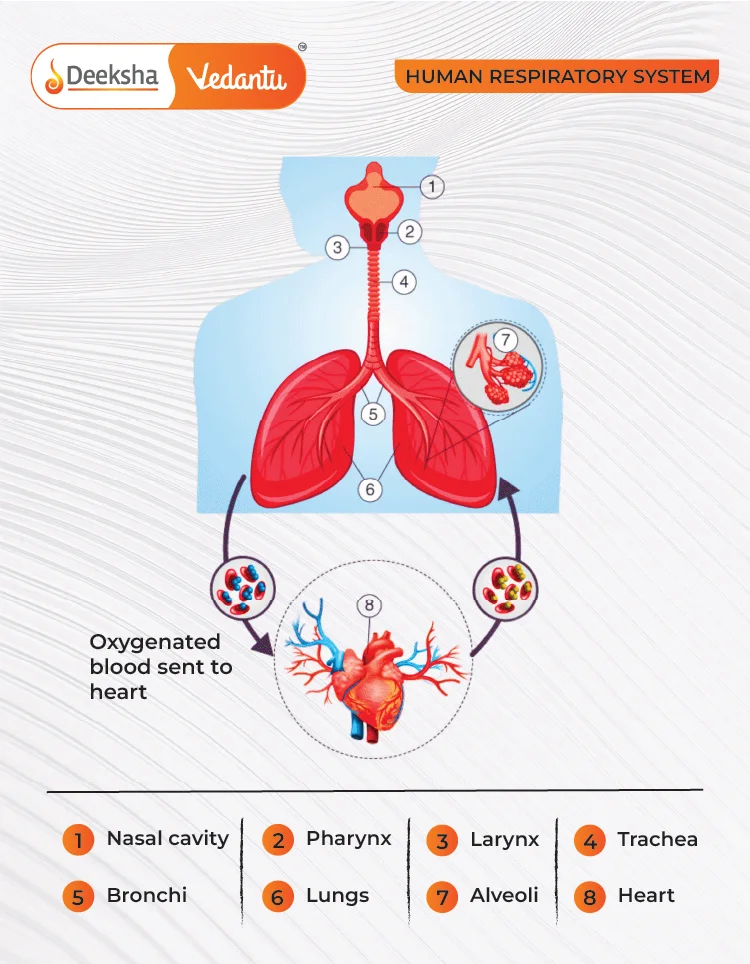Overview of the Human Respiratory System
The human respiratory system is a crucial biological system consisting of specific structures and organs that facilitate the inhalation and exhalation of air, thereby allowing for the essential exchange of gases – oxygen and carbon dioxide – vital for cellular metabolism.
Introduction to the Respiratory System
The primary purpose of the respiratory system is to deliver oxygen to various parts of the human body and remove carbon dioxide. This system includes the airways, lungs, and the respiratory muscles. Molecules of oxygen and carbon dioxide are passively exchanged, by diffusion, between the gaseous external environment and the blood. This exchange process occurs in the alveolar region of the lungs.
Key Components of the Human Respiratory System

- Nose and Nasal Cavity: The nose is the primary entry point for air. The nasal cavity is lined with a mucous membrane and fine hairs that help filter out dust and other particles from inhaled air, warming and moistening it before it enters the lungs.
- Pharynx (Throat): This muscular tube starts at the back of the nose and descends to the larynx. It serves dual functions—conducting air to the lungs and routing food to the stomach.
- Larynx (Voice Box): Located at the top of the trachea, the larynx is a cartilaginous structure that houses the vocal cords. It is instrumental in phonation and protects the trachea against food aspiration.
- Trachea (Windpipe): The trachea filters the incoming air and branches into the bronchi. It is reinforced with C-shaped cartilaginous rings that prevent its collapse.
- Bronchi and Bronchioles: The trachea divides into two main bronchi (one for each lung), which further divide into smaller bronchioles. These bronchioles terminate into tiny air sacs called alveoli.
- Lungs: The lungs are paired organs located in the thoracic cavity, protected by the rib cage. They are the primary organs responsible for gas exchange.
- Alveoli: These are microscopic sacs where the exchange of oxygen and carbon dioxide takes place. They greatly increase the surface area of the lungs.
How the Respiratory System Works
The process of breathing starts with the inhalation of air through the nose, where it is filtered, humidified, and warmed. The air then passes through the pharynx and larynx into the trachea. The trachea forks into two main bronchi, each entering one lung. Inside the lungs, the bronchi subdivide repeatedly into smaller airways, ending at the alveoli.
The exchange of gases occurs in the alveoli. Oxygen from the inhaled air diffuses into the blood, and carbon dioxide from the blood diffuses into the alveoli, to be exhaled out of the body. This efficient gas exchange is critical for the maintenance of the body’s metabolic needs.
Functions of the Respiratory System
- Gas Exchange: Primary function, where oxygen is absorbed, and carbon dioxide is released.
- Voice Production: Air movement through the vocal cords during exhalation produces sound.
- Olfaction: The sense of smell occurs when airborne molecules are drawn into the nasal passages.
- Protection: Respiratory system protects against disease by removing pathogens and other particulates from the air.
Disorders of the Respiratory System
Various diseases can impair the function of the respiratory system. Conditions such as asthma, bronchitis, COPD, and lung cancer can severely affect breathing. Infections like influenza and pneumonia can temporarily compromise the respiratory system’s effectiveness.
Maintaining Respiratory Health
Preventative measures such as avoiding smoking, minimizing exposure to pollutants, regular exercising, and maintaining a healthy diet can help keep the respiratory system robust and efficient.
FAQs
Avoiding pollutants, not smoking, regular exercise, and a healthy diet are key to maintaining respiratory health.
Common disorders include asthma, COPD, bronchitis, pneumonia, and lung cancer.
Major parts include the nasal cavity, pharynx, larynx, trachea, bronchi, lungs, and alveoli.
Air enters through the nose or mouth, travels down the trachea to the lungs, and reaches the alveoli where gas exchange occurs.
The main function is to facilitate the exchange of oxygen and carbon dioxide between the body and the environment.
Related Topics
- Control and Coordination
- Modes Of Reproduction Used By Single Organisms
- How Do Our Activities Affect The Environment?
- Plant Cell
- Water Pollution And Its Control
- What Are Life Processes?
- Ecosystem
- Greenhouse Effect
- Accumulation Of Variation During Reproduction
- Biodiversity
- Nutrition
- Mitosis And Meiosis
- Heredity
- Ozone Layer and its Depletion
- Coordination In Plants









Get Social